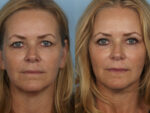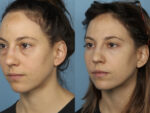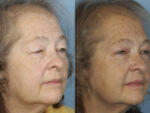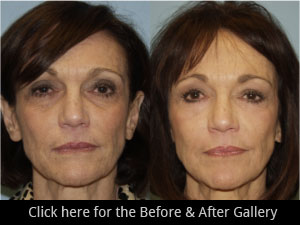Upper and Lower Lid Blepharoplasty Surgery
Blepharoplasty (or eyelid surgery) is the procedure that improves the aged appearance of the eyelids. It may be performed on both the upper and lower eyelids to remove excess skin and protruding fat.
Upper lid blepharoplasty surgery will remove the excess fat and wrinkled, drooping skin of the upper eyelids that can make you look tired or sad. Fat and skin are removed through a well-hidden incision placed in the upper lid crease, which is a natural fold in the skin.
Lower lid blepharoplasty surgery will remove or reposition the excess fat (“bags” under your eyes) and tighten the skin to give you a more rested, youthful appearance. The incisions and approach are tailored to each individual patient based on which features need to be addressed. In many cases, the incision is placed on the inside of the eyelid, which is not visible at all. When you come in for your consultation with Dr. Sidle, he will review your surgical plan with you in detail.
When you come in for your consultation with Dr. Sidle, he will review your surgical plan with you in detail, which may also include a brow lift to achieve optimal rejuvenation in the upper face area.
Additional Read: 5 Reasons Women in Their 30s and 40s Consider Eyelid Surgery
How much does it cost to get a blepharoplasty surgery?
A lower eyelid surgery can run anywhere from $1,500 to $3,000. Upper eyelid surgery may cost anywhere from $2,500 to $5,000. However, the cost can vary depending on the doctor’s experience and where you live.
Who is a good candidate for blepharoplasty?
A person with droopy eyelids and/or puffy eyes who notice reduced vision is a good candidate for blepharoplasty. The goal of the procedure is to remove excess skin and any fat that collects within the upper or lower eyelid, along with bags or dark circles that may be present beneath the eyes. Blepharoplasty cannot cure eye problems such as Bell’s palsy or cataracts; however, these are not always disqualifiers for surgery. Before undergoing this process, it’s essential to consult an ophthalmologist as they can provide input on what effect your eyesight will have following the procedure and any additional steps necessary to preserve sight.
What you can expect after surgery?
Sutures are generally removed within 5-7 days. Healing time is minimized by careful surgical technique. In most cases, this surgery can be performed in our office’s procedure room under light sedation. It may also be performed as an outpatient surgery in the operating room at Northwestern Memorial Hospital. Slight bruising and swelling will typically resolve in less than 1 week.
How long does it take for eyelid surgery to heal?
The healing process for eyelid surgery will depend on the type of surgery. Most patients will generally have their stitches removed after about 5-7 days. Most bruising and swelling should be gone in about two weeks, but scars may take up to 9 months to heal completely. The area might be sensitive for a little longer than this, but it’s important not to apply any lotion or wash that might sting around the eye region – such as “oxygenated water.”
Why choose Dr. Sidle for your blepharoplasty surgery?
Dr. Sidle believes in a conservative approach to blepharoplasty. By avoiding excessive removal of tissue, he is able to decrease the risk of complications and prevent an unnatural “wide-eyed” or hollowed appearance after surgery. As with all of his surgical procedures, Dr. Sidle strives for an improved but natural appearance. Depending on your goals, blepharoplasty can be performed by itself or in conjunction with a facelift or browlift to rejuvenate the aging face.
Experience Matters. As a double board-certified Facial Plastic Surgeon at Northwestern with special expertise in rejuvenation of the eyes and face, Dr. Sidle can provide you with an individualized plan to restore a more youthful appearance to your face. Call our office for a one-on-one consultation.
Blepharoplasty FAQs
A “Pinch Blepharoplasty” is a minimally invasive technique in which only the excess skin is addressed. Because the incisions are made in natural skin folds of the eyelids just below your eyelashes, they are nearly invisible after the healing process is complete.
No, the surgery is not painful. It’s also a safe and standard procedure that takes less than 1 hour to carry out as it only requires local anesthetic as analgesia. Although many patients are often anxious before the operation, they notice little discomfort while being carefully monitored by their surgeon during the eyelid procedure. Patients can return to work 4-5 days after this cosmetic surgery if their daily activities don’t involve strenuous activity or heavy lifting. Eyelid surgery is quick and painless for people who need enhancement or improvement to transform their lives immediately.
The best age for blepharoplasty may vary depending on the individual’s circumstances. However, in general, blepharoplasty is typically most successful when performed on patients in their 40s or 50s. This is because the skin around the eyes begins to thin and sag as we age, which can lead to a tired or aged appearance. By performing blepharoplasty at a younger age, some of these signs of aging can be prevented or reversed.
Typically, most people see a noticeable difference in appearance within two weeks of the surgery. However, the full results may not be visible until four to six weeks post-surgery. Bruising and swelling typically subside within two weeks. Some mild swelling may persist for up to six months after surgery.
Blepharoplasty is a surgical procedure that improves the appearance of the eyelids by removing excess fat, skin, and muscle from the upper and lower eyelids. The results of blepharoplasty are usually permanent. However, there is a slight chance that the eyelid may sag or droop over time; another round of surgery may be required.
Not necessarily, but there is a chance that you may need to repeat your eyelid surgery.
The majority of eyelid surgeries are successful, and complications are rare. However, there is always the possibility that something may go wrong during or after surgery that could require a second surgery. Some common complications that may necessitate a second surgery include excessive bleeding, infection, damage to the eye or eyelid, and unsatisfactory cosmetic results.
If you experience any problems after your eyelid surgery, be sure to consult with your doctor right away. If it turns out that you do need to have a second surgery, there is no need to worry. Most patients report being very happy with the results of their second procedure.
You should ensure your hands are clean before touching your face. Gently massage the area around the eye several times a day. It’s essential to keep your hands and towel down by your side when rubbing near the eyes, as it’s really easy to touch or rub against parts of the eyeball and poke yourself in there. Remember to gently massage the area around your eye several times per day for weeks following surgery with soap-free cream or lotion after thoroughly moistening your skin with water. Once you run out of that, use moisturizer without additional chemicals. Another thing: avoid putting anything cold onto an eye.
Blepharoplasty can help make you look younger. The procedure removes excess skin on the upper eyelids and creates an eye that is more open, alert, and youthful. It also tightens sagging skin in the lower lid to make a smooth appearance.
A blepharoplasty is safer than many other surgical procedures because it involves no major muscle cutting, no cracking open of the skull, and usually requires a shorter recovery time.
Some risks include bleeding and bruising under the eye or forming fluid between the thin layers that form the skin. However, as long as those issues are quickly addressed with a doctor who is knowledgeable about this surgery, there don’t tend to be severe complications.
Blepharoplasty is a surgical procedure to remove excess fat, skin, and muscle from the eyelids. It can be performed by a plastic surgeon or an ophthalmologist who is a licensed medical doctor. So it’s important to find a qualified and experienced surgeon to ensure the best possible results.
Post-operative Instructions
All post-operative instructions can be found on the Patient Resources page.
Our Results
Click here to access Dr. Sidle’s Before & After Gallery for all procedures.






